 |
 |
 |
 |
 |
 |
 |
 |
 |
 |
 |
 |
 |
 |
 |
 |
 |
 |
 |
 |
 |
 |
 |
 |
 |
 |
 |
 |
 |
 |
 |
 |
 |
 |
 |
 |
 |
 |
 |
 |
 |
 |
|
|
Romanesque - 1 |
|
|
|
 |
|
|
|
Introduction
The Romanesque is the art style that lasted approximately between the year 1000 to 1250 in Western Europe. In Portugal, the style began comparatively later and lasted longer than in many other regions. Count Henry of Portucale sponsored considerable building activity at the turn of the 11th to the 12th century, specially at the Cathedral of Braga, the Count Palace at Guimaraes and in monasteries like Saint Peter of Rates. During the first half of the 12th century, the first king of Portugal, Afonso Henriques, also sponsored important buildings in Romanesque style like the church of Saint John of Almedina and the Monastery of the Saint Cross, both located in the kingdom�s first capital, Coimbra. All of these buildings have either been lost or radically remodelled in later times. Most extant Portuguese Romanesque religious buildings started being built in the second half of the 12th century, and in many cases construction went on into the 13th century, blending with gothic forms. Authentic Romanesque buildings are missing from Southern Portugal, since these regions were reconquered by Christians only during the 13th century. |
|
|
|
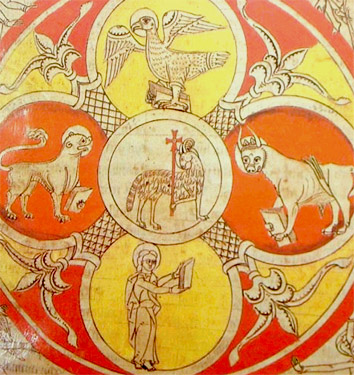 |
|
|
|
Right - Folio (detail) of a Beatus of Liebana's Commentary on the Apocalypse copied and illuminated in the Monastery of Lorvao around the year 1187. The Lamb of God (representing Jesus Christ), holding the Cross, is surrounded by the symbols of the four Evangelists.
Torre do Tombo National Archive, Lisbon |
|
|
|
|
|
In the period between the second half of the 12th and early 13th century, the first Portuguese kings promoted the building or renovation of the cathedrals of the most important cities of the young kingdom, like the ones in Braga, Oporto, Coimbra, Lamego, Viseu and Lisbon. Of these, only the Old Cathedral of Coimbra (S� Velha de Coimbra) has been fully preserved in its original Romanesque form. The cathedrals of Lisbon, Oporto and Braga have been strongly modernised in the Gothic and Baroque periods, and have retained only parts of the nave and some portals in the original Romanesque form. Romanesque towers have been preserved, although altered, in the cathedrals of Lisbon, Oporto, Viseu and Lamego.
Old Cathedral of Coimbra
Braga Cathedral
Oporto Cathedral
Lisbon Cathedral |
|
|
|
Another important Romanesque site is the Round Templar Church of the Templar Knight's in the Convent of Christ in Tomar. |
|
|
|
 |
|
|
|
Most Romanesque buildings in Portugal are ancient monastic churches found specially in the Northwestern part of the country. The church of the old Benedictine Monastery of Rates, near Oporto, is one of the most important of these. The present church was begun under Count Henry in the end of the 11th century, but was greatly modified starting in the middle of the 12th century. The church has three Eastern chapels, transept and a three-aisled nave with a wooden ceiling. The last part of the church to be completed was the main fa�ade, which has a portal with notable (although eroded) sculptered decoration, with a tympanum showing Christ encircled by a mandorla and accompained by St Peter and St Paul. The archivolts of the portal depict reliefs of bishops an angels. |
|
|
|
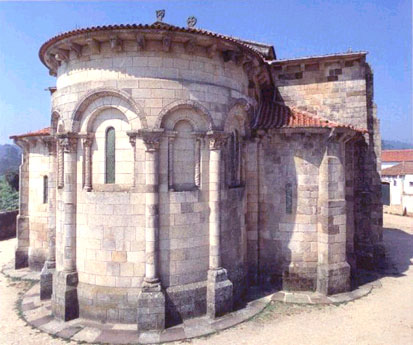 |
|
|
|
Left - East side of the church of Rates. The elegant Romanesque main chapel shows a beautiful interplay of long columns, arches and windows. The capitals are decorated with vegetal and geometrical motifs of very early design. The lateral chapels and one arm of the transept are also seen. |
|
|
|
|
|
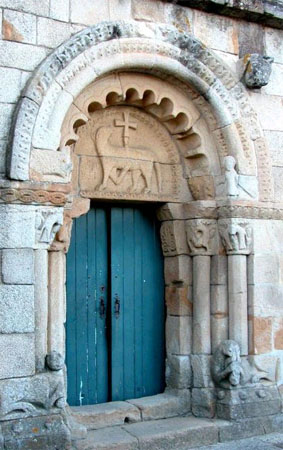 |
|
|
|
|
Right - South portal of Rates. The portal is heavily decorated with several geometrical motifs and features a tympanum with the Agnus Dei (the Lamb of God) looking back at the Cross. On the base of an archivolt an angel (St Mathew's symbol?) can be seen. The capitals of the columns depict beasts attacking human figures, and the bases of the outer columns are supported by lions eating humans - very direct representations of Divine Justice made to mediaeval worshippers, who were mostly illiterate. |
|
|
|
|
|
|
 |
|
|
|
Another important Romanesque site is the church of Manhente, near Braga. The building, which was part of a Benedictine monastery, can be dated to the first half of the 12th century, being one of the earliest surviving Romanesque churches in Portugal. One inscription in the church gives the date 1117 and the name of Master Gon�alves (Gundisalves) as the architect, something very rare in the Romanesque era. |
|
|
|
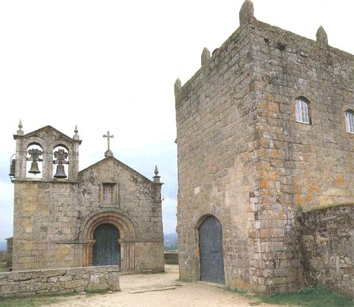 |
|
|
|
Left - View of the church of Manhente. The fa�ade of the church has the original Romanesque portal. The Gothic defensive tower, possibly from the 14th century, was also part of the ancient Benedictine monastery. Archaeological surveys have shown that the present church was preceeded by an earlier, pre-Romanesque one. |
|
|
|
|
|
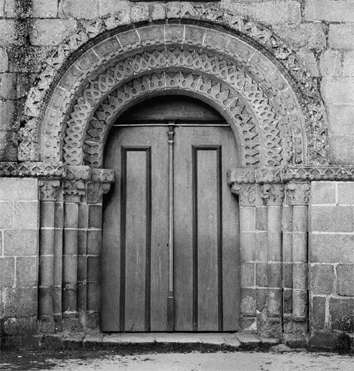 |
|
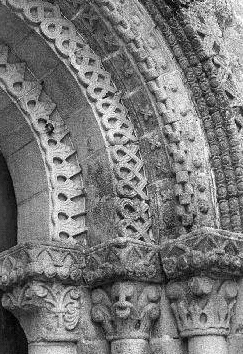 |
|
|
|
|
|
Up - The most striking feature of the church is its richly decorated main portal. Its antiquity is releaved by its almost horseshoe shape and the decoration, similar to some old motifs found in Braga, Rates and elsewhere. Each archivolt is decorated with a different geometrical motif, and the capitals have various vegetal motifs, again different from one another. This profusion of motifs is typical of Portuguese Romanesque. |
|
|
|
 |
|
|
|
Page 2
Index |
|





